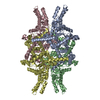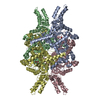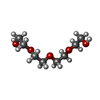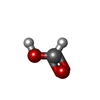+Search query
-Structure paper
| Title | Structural insights into the targeting specificity of ubiquitin ligase for S. cerevisiae isocitrate lyase but not C. albicans isocitrate lyase. |
|---|---|
| Journal, issue, pages | J Struct Biol, Vol. 213, Issue 3, Page 107748, Year 2021 |
| Publish date | May 24, 2021 |
 Authors Authors | Keito Hiragi / Kazuya Nishio / Shu Moriyama / Tasuku Hamaguchi / Akira Mizoguchi / Koji Yonekura / Kazutoshi Tani / Tsunehiro Mizushima /  |
| PubMed Abstract | In Saccharomyces cerevisiae, the glyoxylate cycle is controlled through the posttranslational regulation of its component enzymes, such as isocitrate lyase (ICL), which catalyzes the first unique ...In Saccharomyces cerevisiae, the glyoxylate cycle is controlled through the posttranslational regulation of its component enzymes, such as isocitrate lyase (ICL), which catalyzes the first unique step of the cycle. The ICL of S.cerevisiae (ScIcl1) is tagged for proteasomal degradation through ubiquitination by a multisubunit ubiquitin ligase (the glucose-induced degradation-deficient (GID) complex), whereas that of the pathogenic yeast Candida albicans (CaIcl1) escapes this process. However, the reason for the ubiquitin targeting specificity of the GID complex for ScIcl1 and not for CaIcl1 is unclear. To gain some insight into this, in this study, the crystal structures of apo ScIcl1 and CaIcl1 in complex with formate and the cryogenic electron microscopy structure of apo CaIcl1 were determined at a resolution of 2.3, 2.7, and 2.6 Å, respectively. A comparison of the various structures suggests that the orientation of N-terminal helix α1 in S.cerevisiae is likely key to repositioning of ubiquitination sites and contributes to the distinction found in C. albicans ubiquitin evasion mechanism. This finding gives us a better understanding of the molecular mechanism of ubiquitin-dependent ScIcl1 degradation and could serve as a theoretical basis for the research and development of anti-C. albicans drugs based on the concept of CaIcl1 ubiquitination. |
 External links External links |  J Struct Biol / J Struct Biol /  PubMed:34033899 PubMed:34033899 |
| Methods | EM (single particle) / X-ray diffraction |
| Resolution | 2.3 - 2.69 Å |
| Structure data | EMDB-31053, PDB-7ebf:  PDB-7ebc:  PDB-7ebe: |
| Chemicals |  ChemComp-MG:  ChemComp-PG4:  ChemComp-HOH:  ChemComp-FMT: |
| Source |
|
 Keywords Keywords | LYASE / Isocitrate lyase / glyoxylate cycle / ubiquitination |
 Movie
Movie Controller
Controller Structure viewers
Structure viewers About Yorodumi Papers
About Yorodumi Papers





 candida albicans (yeast)
candida albicans (yeast)